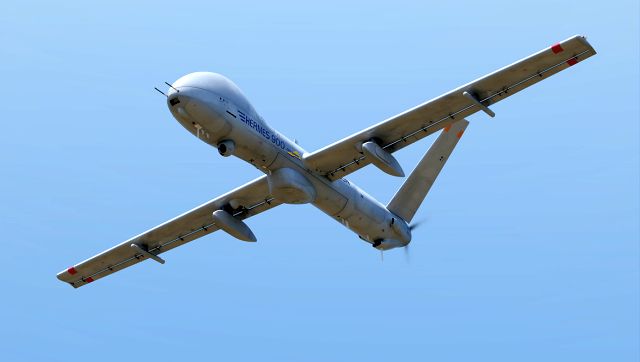India’s eyes in the skies are about to get stronger and better. The Indian Armed Forces are set to acquire additional Israeli medium-altitude, long-endurance unmanned aerial vehicles. In simple parlance, the Armed Forces are procuring new drones from Israel. Of the drones being purchased, the Indian Army and Navy are procuring the Hermes 900 manufactured by Elbit Systems, while the Air Force has procured the Heron Mk2 from Israel Aerospace Industries. The Hindu, citing defence sources, have said, that the contracts have been concluded and the deliveries are expected early next year. We take a closer look at these Hermes 900 drones, their capabilities and how their induction in the Indian Armed Forces will be a boost to our reconnaissance and surveillance capabilities. About Israel’s Hermes 900 Designed and manufactured by Elbit Systems, the Hermes 900 is a large medium-range long endurance (MALE) class of drone designed for tactical missions. It can perform a wide range of missions including persistent intelligence, surveillance, target acquisition and reconnaissance (ISTAR). According to its specifications, the Hermes 900 has the endurance of up to 36 hours in a single sortie and has a payload capacity of 350 kg. Moreover, it maximum ceiling is 30,000 feet. The Hermes 900 is equipped with a variety of high performance sensors, allowing it to detect ground or maritime targets, over a wide spectral range. It can also be used for attacks on ground targets. The drone also has composite structures and built-in growth potential. It is also equipped with modern avionics such as an air traffic control (ATC) radio, radio relay, and an identification friend or foe (IFF) transponder. The Hermes 900 also comes with electro optical and infra-red sensors, making it one of the most preferred drones of the Israeli Air Force. [caption id=“attachment_13368182” align=“alignnone” width=“640”] The Hermes 900 can perform a wide range of missions including persistent intelligence, surveillance, target acquisition and reconnaissance. Image Courtesy: elbitsystems.com[/caption] Hermes 900 in operations The Hermes 900 (Kochav), which means star in Hebrew, was inducted into the Israeli forces back in 2012 and was first used in the Protective Edge operation against Hamas in Gaza in 2014. For those who don’t know, Protective Edge operation was a seven-week battle during which more than 2,000 Palestinians died and more than 10,000 people injured. The Hermes 900 was also used during the Second
Nagorno-Karabakh War fought between Armenia and Azerbaijan. Armenia’s defence ministry spokesperson had then stated that their forces had shot down an Azerbaijani Hermes 900 drone, a claim refuted by Azerbaijan. The Hermes 900 UAVs are also currently in use in the ongoing Israel-Hamas war. As Israel advances into the heart of
Gaza City in its war against Hamas, they have extensively used drones to lead the attack. Some reports also state that Israel is using to map out the tunnels that twist and turn below the coastal enclave. Israel has extensively used the Hermes 900 to eliminate Palestinian militant leaders and attack other targets. [caption id=“attachment_13368292” align=“alignnone” width=“640”]
Israeli prime minister Benjamin Netanyahu in front of a Hermes 900 drone. These drones have become a mainstay of the Israeli Air Force and has been used in the ongoing Israel-Hamas war too. File image/Reuters[/caption] A boost to India India has signed a contract for Israel’s Hermes 900 Starliners, a deviation of the drone, which is the unarmed one that is primarily meant for intelligence-gathering, surveillance and reconnaissance. A defence source quoted by The Hindu said, “The induction of Remotely Piloted Aircraft System (RPAS) Heron MKII and planned induction of Hermes 900 Starliners will not only boost the reconnaissance and surveillance capability of the Indian Army but also their teaming with combat helicopters will prove to be a game changer in the third dimension.” The Starliner variation is meant to fly over civilian airspace and is billed as an option for anything from homeland defence, law enforcement to aiding in fighting fires. Amir Bettesh, vice-president of marketing and business development at Elbit’s UAS business unit, had previously told Breaking Defense that the Starliner can fly over populated areas which military planes generally avoid, giving the drone the “the double application for military and civilian”. Such a drone will be handy for India around the Line of Actual Control (LAC) and Ladakh with its difficult terrain and adverse weather conditions. It will provide India with better eye over China’s movement along the LAC.
**Also read: How cheap drones helped Hamas ambush Israel's sophisticated weaponry** Drones, the new front in warfare The ongoing wars in the world – the Russia-Ukraine war and the Israel-Hamas war – have thrown a spotlight on the important role of drones in warfare. Liran Antebi, a drone technology expert at the Institute for National Security Studies (INSS) in Tel Aviv, told NBC News, “Drones have been called ‘the poor man’s air force,’ since they provide a cheap way of gathering information and attacking from the air with relative precision, a capability that was formerly the preserve of advanced states.” India has realised the potential and significance of drone warfare and has been purchasing and developing its own indigenous drones. In the past, the Indian Air Force has purchased Heron Mark 2 drones from Israel. In June, India also cleared the decks to purchase
MQ-9B Reaper drones from the United States. Later in July, it was also reported that the nation would acquire 97 ‘Made-in-India’ drones for surveillance purposes along China and Pakistan borders. With inputs from agencies
India’s surveillance and reconnaissance capabilities are about to get a boost with the purchase of the Israeli Hermes 900 drones. These unmanned aerial vehicles, being used in the ongoing war against Hamas, are equipped with a variety of high-performance sensors and modern avionics
Advertisement
End of Article


)

)
)
)
)
)
)
)
)



